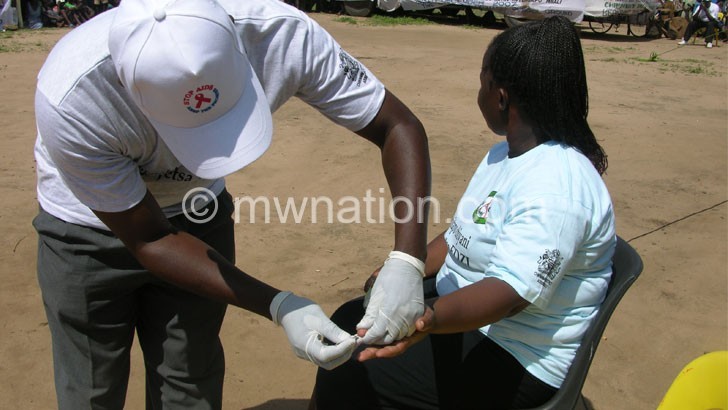AIDS, TB gains under threat
Three months after International Aids Society (IAS) rated Malawi as on course to end HIV and Aids and tuberculosis (TB) by 2030, a new Médecins Sans Frontières (MSF) report shows funding gaps threaten to wipe the gains.
During the 2019 Aids Conference in Mexico in July, IAS announced that Malawi was among six countries making progress towards ending the epidemic.

However, figures MSF released this week indicate that the national and global responses to the two deadliest infectious diseases are veering off target due to funding gaps.
The Doctors without Borders examined the health and HIV/TB financing in Malawi, Central African Republic, Democratic Republic of Congo, eSwatini, Guinea, Kenya, Mozambique, Myanmar, and Zimbabwe.
The findings show that without increased external funding to cover gaps, many people in Malawi will be unable to access necessary healthcare.
According to the new evidence, the shortfalls also jeopardises the push to end Aids by ensuring 90 percent of people with HIV know their status, 90 percent of those diagnosed with the virus are put on treatment and 90 percent of those on treatment take it consistently until the virus becomes undetectable.
In the race for the 90-90-90 goals backed by the United Nation Joint Aids Programme (UNAids), the Ministry of Health requires everyone who tests HIV positive to start taking antiretroviral drugs immediately.
The test-and-treat strategy has accelerated the pace and UNAids reports that an astonishing 91 percent of people with HIV know their status, 83 percent of them are taking ARVs and 90 percent are achieving suppressed viral load.
However, MSF warns that this could be a miracle on quicksand in the absence of financial inflows to strengthen the national response.
The report reads: “Malawi is confronted with a shortfall in ARV supply, including K5.3 billion ($7.1 million) needed to effectively implement a rapid switch to Dolutegravir (DTG). An additional K2.9billion ($3.9 million) is needed to enable a planned scale up of point-of-care viral-load testing as per current WHO treatment guidelines.
“The gap for case detection and treatment of people with multi-drug-resistant tuberculosis (MDR-TB) is estimated at K 1.1billion ($1.5 million) and in order to apply TB preventative therapy as required, the current gap of K4.6 billion ($6.1 million) needs to be addressed,” reads the report.
MSF also shine a light on severe shortages of health workers, estimating the vacancy rate at 51.
The findings read: “Current levels of training for health workers—nurses and midwives—are not keeping up with the needs. Moreover, due to recruitment caps, only half of the trained staff had been absorbed on the pay roll in 2016.
“Estimates indicate that by 2022 Malawi will need to spend at least $775 million per year to maintain the status quo in line with population growth, the number is far more than the 2017-2018 allocated budget of approximately $177 million.”
Malawi reported gaps includes the gap in the country’s resources for HIV increased from five percent in 2017 to 22 percent in 2019 and was expected to widen to 43 percent in 2021.
The report said currently Global Fund and Pepfar provide critical funding in Malawi for health personnel since Pepfar supports 13 066 staff and within COP19 an additional 550 health workers will be supported in 2019/20.
“Key population-focused interventions supported by Pepfar and Global Fund, underestimate the size of some key populations and have resulted in the insufficient resourcing of related programmes,” adds the report.
The report also observed that there was a reduced focus on implementation of community interventions and the ability of civil society organisations (CSOs) to play their role in treatment literacy, monitoring and advocacy is affected. Existing CSOs are being redirected away from HIV and Aids and TB or closing shop.
Ministry of Health spokesperson Joshua Malango said funding was a challenge in many areas and there was a need to manage population which threatens the gains from all other previous interventions.
He said government has consistently increased budget lines to health and an example is the 2019/20 provisions including increases in the drug budget across the sector.
“Take note that systems strengthening are also important, including human resource issues. Government and its partners continue to recruit health care workers,” Malango said.
He said that the population is real challenge, especially when it is a young people getting infected resulting in a high dependency ratio.
On the global trends in finance was generally declining across sectors for various reasons saying: “Efficiency is the talk now. Doing more with what is available.”
He said government was making strategic interventions.
“Construction of roads reduces wear and tear on the roads for our ambulances and improves the referral system. In essence Malawi government has adopted ‘Health in All Policies’,” he said, adding that in general Malawi was improving its annual allocation to health.
In the 2019/20 K1.7 trillion National Budget the health sector was allocated K101 billion.
Malawi Health Equity Network (Mhen) executive director George Jobe said he agreed with the report that funding in HIV and TB has indeed gone down, as globally the emphasis of treatment has affected other interventions like prevention.
“Local organisations that were in HIV programmes have either died or are dormant. The funding problems have also affected key organisations like Macro, Napham as well as Manet+. Community based organisations (CBOs) that were important in activities that emphasise on preventions are no longer active,” he said.
Jobe observed that the 90:90:90 initiative was also emphasizing on treatment not on prevention.
He, however, said gains have been made in provision of ARVs and testing.
The report says Malawi continues to progress towards achieving the 90-90-90 targets for HIV prevention, treatment and viral suppression.
“Of the approximately 810 000 PLHIV on ART, 69 percent were virally suppressed in 2018. That year marked 13 000 deaths due to Aids and 38 000 new HIV infections and on TB from 2010 to 2017, TB incidence declined from 332 to 131/100 000 and decreased even more sharply, among PLHIV from 270 to 65/100 000. The HIV prevalence is 49 percent among TB patients. TB treatment coverage is approximately 68 percent,” reads the report.
In the Malawi National Strategic Plan for HIV and Aids 2015– 2020, government recognised the resource constraint scenario and prioritised the plan to fit within the existing resource envelope assuming a chance that the current commitments from domestic and external pool will remain the same during the NSP lifespan.
Reads the National Health Strategic Plan: “A moderate increase in resources – this assumes a 30 percent increase in the current resource envelope. The assumption is based on a likelihood of additional resources from current Health Financing efforts, possibility of succeeding with the GF unfunded quality demand and incentive funding. We also assume an optimistic increase in partner commitment.”





